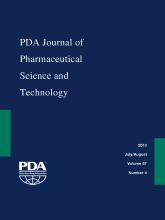Abstract
Storing protein formulations in the frozen state typically improves stability during long-term storage as a drug substance or as a drug product. The frozen state minimizes chemical degradation and physical instability. However, the frozen state is not an optimal storage condition for the glass vial itself. A significant issue was observed when small, flake-like pieces of glass particles (lamellae) appeared in vials containing thawed protein product. The occurrence of glass particles during freeze-thaw results in product rejection and potentially, adverse events. In recent years, glass flakes due to chemical delamination have been observed in parenteral liquid formulations after long-term storage, resulting in a number of product recalls. In this study, for the first time, glass delamination is reported in pharmaceutical glass vials containing frozen protein formulation, caused by a novel mechanism involving thermally-induced mechanical stress.
In this article, a monoclonal antibody drug product in glass vials and the corresponding placebo vials were studied to identify the contributing factors from the freeze-thaw process, such as freezing temperature, the presence or absence of protein, and other handling conditions. Freezing temperature was found to be the most critical factor. Glass lamellae were only observed when the products were frozen to −70 °C, while freezing only to −30 °C did not cause any lamellae formation even after multiple freeze-thaw cycles. Protein concentration and the handling of the vials were also identified as contributing factors. A concentration gradient which formed after freeze-thaw induced a higher rate of lamellae occurrence in a subsequent freeze-thaw cycle compared to vials without the concentration gradient. Analyses by Fourier transform infrared spectroscopy and scanning electron microscopy/energy dispersive spectroscopy confirmed that the flake-like lamellae were thin, flat glass particles. Defects corresponding to the glass flakes were observed by scanning electron microscopy on the inner surface of the vials that contained lamellae. In addition, inductively coupled plasma mass spectrometry testing did not show elevated levels of silicon in the drug product solution, suggesting that the glass lamellae formed in the frozen vials was a local, event-based phenomenon rather than silica dissolution from the product contact surface or glass degradation caused by corrosive attack. These findings can be explained by the same thermally-induced mechanical stress which caused vial breakage. Frozen protein formulations contracted below −30 °C, causing an inward glass deformation and a subsequent rapid movement of the glass when the frozen plug of drug product solution separated from the vial inner surface at approximately −50 to −60 °C. The mechanical stress released during this separation caused vial breakage. The incidence of vial breakage increased with more concentrated product and higher fill volume–to–vial volume ratios. The same mechanism applies to lamellae formation. As the rapid surface separation occurred, small, thin pieces of glass were pulled from the glass surface by the frozen plug, and, as a result, glass lamellae particles appeared in the drug product solution after thawing.
LAY ABSTRACT: In recent years, glass flakes have been observed in parenteral liquid formulations due to chemical delamination during long-term storage, resulting in a number of product recalls. In our study, we discovered a novel mechanism of glass delamination in vials containing frozen protein formulations. This glass delamination mechanism has never been reported before, and we believe this work will benefit the pharmaceutical scientific community, especially the biotechnology and parenteral drug industries.
Storing protein formulations in the frozen state typically improves stability during long-term storage as a drug substance or as a drug product. The frozen state minimizes chemical degradation and physical instability. However, the frozen state is not an optimal storage condition for the glass vial itself. In this study, we observed that after thawing, small, flake-like pieces of glass particles (i.e., lamellae) appeared in vials containing frozen protein formulation. To investigate the root cause, we performed a series of freeze-thaw experiments and characterized the lamellae particles, the vial inner surface, and the elemental composition of the solution. The root cause was determined to be mechanical stress caused by thermal contraction of frozen protein formulations below −30 °C. This contraction caused an inward glass deformation on the vial sidewall and, subsequently, the glass vial surface abruptly separated from frozen protein formulation. Under this mechanical stress, small, thin glass pieces were peeled from the vial inner surface by the frozen formulation, causing lamellae formation. The experimental design and results leading to the discovery of the novel glass delamination mechanism are presented in detail in this article.
- © PDA, Inc. 2013
PDA members receive access to all articles published in the current year and previous volume year. Institutional subscribers received access to all content. Log in below to receive access to this article if you are either of these.
If you are neither or you are a PDA member trying to access an article outside of your membership license, then you must purchase access to this article (below). If you do not have a username or password for JPST, you will be required to create an account prior to purchasing.
Full issue PDFs are for PDA members only.
Note to pda.org users
The PDA and PDA bookstore websites (www.pda.org and www.pda.org/bookstore) are separate websites from the PDA JPST website. When you first join PDA, your initial UserID and Password are sent to HighWirePress to create your PDA JPST account. Subsequent UserrID and Password changes required at the PDA websites will not pass on to PDA JPST and vice versa. If you forget your PDA JPST UserID and/or Password, you can request help to retrieve UserID and reset Password below.






